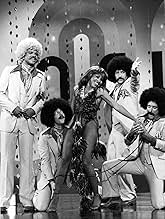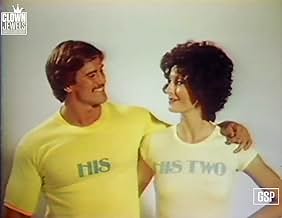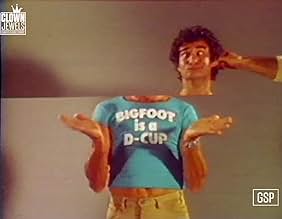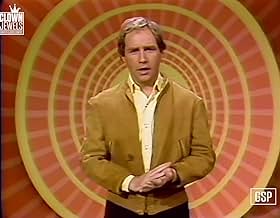Añade un argumento en tu idiomaThis short-lived reboot of the Dan Rowan / Dick Martin comedy series was performed by numerous comic actors in a showcase for the talents of Robin Williams, Lenny Schultz, June Gable, Ben Po... Leer todoThis short-lived reboot of the Dan Rowan / Dick Martin comedy series was performed by numerous comic actors in a showcase for the talents of Robin Williams, Lenny Schultz, June Gable, Ben Powers, Wayland Flowers and Madame, and others.This short-lived reboot of the Dan Rowan / Dick Martin comedy series was performed by numerous comic actors in a showcase for the talents of Robin Williams, Lenny Schultz, June Gable, Ben Powers, Wayland Flowers and Madame, and others.
- Nominado para 2 premios Primetime Emmy
- 2 nominaciones en total
Explorar episodios
Argumento
¿Sabías que...?
- CuriosidadesProducer George Schlatter relaunched the series without creators and hosts Dan Rowan and Dick Martin, who later won a 4.6 million dollar lawsuit against Schlatter for continuing the show without their permission.
- ConexionesFeatured in Yap: How Did You Know We'd Like TV? (1981)
Reseña destacada
George Schlatter's late '70s reboot doesn't have a great reputation, and its primarily remembered today as the show that launched the career of Robin Williams. That's a little unjust on both accounts. "Rowan and Martin's Laugh-In" was already showing its age as the 1970s began, and it was finally put out of its misery in 1973. Four years later, producer George Schlatter assembled a completely new cast and rebooted the show for a series of six specials without the original frontmen... which was a mistake that literally cost him millions of dollars when Rowan and Martin sued.
The original show seemed to exist in a puff of pot smoke, but if there was one drug that fueled the frenzied new incarnation, it was cocaine. As a matter of fact, in a moment that I can't believe the censors let pass, an animated Robin Williams is shown sniffing coke, and then his head explodes and he dies! The Rowan & Martin show certainly never did anything so grim! A few of the hallmarks of the early version endured - most notably the wall of doors and the one-liner-filled dance sequences - but the show also liberally borrowed from SNL, Benny Hill, Love American Style, and others. Plus, each show featured an overblown original musical number performed by the cast (easily the weakest link in the show). The original had a zippy pace, but the speed here was positively frantic, with few routines lasting more than 30 seconds, and many confined to around 10. They managed to jam A LOT of material into 50 minutes.
Now, as for Robin Williams, as soon as the show wrapped, Garry Marshall had to buy out his contract in order for him to appear as Mork in "Happy Days," which turned Robin into an overnight celebrity. Cashing in on his sudden fame, NBC reran the shows for 6 weeks in 1979, touting him as the star. Unfortunately, he wasn't treated like anything special during the production, he was just one of about 14 members of an ensemble cast, each of whom was vying for screen time. Robin got to play a variety of characters (my favorite was a lab rat), but he was probably most often seen as a dimwitted cowboy.
The next most famous cast member is the flamboyant Wayland Flowers, who was well-known to viewers of daytime game shows and night time talk shows, thanks to his bawdy puppet, Madam, who received equal billing alongside him. On occasion throughout the series, Flowers traded Madam in for a black puppet named Jiffy, who seems shockingly racist by today's standards... but she's a riot!
Also seen were rubber-faced lizard-man Lenny Schultz, who mugged his way through most sketches while contorting his puss and flicking his tongue; doe-eyed Kim Braden, who portrayed a lot of very feminine characters like Dolly Parton; June Gable, who did a wicked impersonation of gossip columnist Rona Barrett; Michael Sklar, who seemed to be completely out of the closet at a time when very few men were; token black guy Ben Powers; and others.
One of the most interesting additions to the cast is Sergio Aragonés, a Mad magazine artist who is known as "the world's fastest cartoonist." Aragonés went on to create animated segments for the long-running "Bloopers and Practical Jokes" shows. We not only get some of the same animation here, but we see that Aragonés himself is the inspiration for the Luigi-like character seen throughout the Dick Clark shows.
As with the original, the humor is hit-and-miss... but when it hits, it hits hard. There are a lot of gags that derive laughs from subverting your expectations, and there's some very topical humor that's amusing if you're in on the joke. Bigot-crusader Anita Bryant was a regular target of ridicule, timely political references were worked in, ABC was humorously criticized for "jiggle-vision," "Soap" was denounced for being dirty, and "Donny & Marie" was just plain denounced! Between the mixture of comedy styles and all of the instantly-dated humor, the show is sort of a time-capsule of 1977.
Bette Davis got to ham it in a few skits, and Frank Sinatra was positively giddy when he got to pour slime on Rona Barrett, but other guests like Shirley MacLaine, James Garner and Roger Moore mostly appeared delivering one-liners. A lot of celebrities did appear though, and the creators often stretched and recycled guest-star material over several episodes.
All in all, it's a shame that this offshoot of the series isn't widely available anywhere. It's not Rowan and Martin's, and it's not The Robin Williams Show either, but some of the material holds up exceptionally well and other things would still seem funny today to those who were there.
The original show seemed to exist in a puff of pot smoke, but if there was one drug that fueled the frenzied new incarnation, it was cocaine. As a matter of fact, in a moment that I can't believe the censors let pass, an animated Robin Williams is shown sniffing coke, and then his head explodes and he dies! The Rowan & Martin show certainly never did anything so grim! A few of the hallmarks of the early version endured - most notably the wall of doors and the one-liner-filled dance sequences - but the show also liberally borrowed from SNL, Benny Hill, Love American Style, and others. Plus, each show featured an overblown original musical number performed by the cast (easily the weakest link in the show). The original had a zippy pace, but the speed here was positively frantic, with few routines lasting more than 30 seconds, and many confined to around 10. They managed to jam A LOT of material into 50 minutes.
Now, as for Robin Williams, as soon as the show wrapped, Garry Marshall had to buy out his contract in order for him to appear as Mork in "Happy Days," which turned Robin into an overnight celebrity. Cashing in on his sudden fame, NBC reran the shows for 6 weeks in 1979, touting him as the star. Unfortunately, he wasn't treated like anything special during the production, he was just one of about 14 members of an ensemble cast, each of whom was vying for screen time. Robin got to play a variety of characters (my favorite was a lab rat), but he was probably most often seen as a dimwitted cowboy.
The next most famous cast member is the flamboyant Wayland Flowers, who was well-known to viewers of daytime game shows and night time talk shows, thanks to his bawdy puppet, Madam, who received equal billing alongside him. On occasion throughout the series, Flowers traded Madam in for a black puppet named Jiffy, who seems shockingly racist by today's standards... but she's a riot!
Also seen were rubber-faced lizard-man Lenny Schultz, who mugged his way through most sketches while contorting his puss and flicking his tongue; doe-eyed Kim Braden, who portrayed a lot of very feminine characters like Dolly Parton; June Gable, who did a wicked impersonation of gossip columnist Rona Barrett; Michael Sklar, who seemed to be completely out of the closet at a time when very few men were; token black guy Ben Powers; and others.
One of the most interesting additions to the cast is Sergio Aragonés, a Mad magazine artist who is known as "the world's fastest cartoonist." Aragonés went on to create animated segments for the long-running "Bloopers and Practical Jokes" shows. We not only get some of the same animation here, but we see that Aragonés himself is the inspiration for the Luigi-like character seen throughout the Dick Clark shows.
As with the original, the humor is hit-and-miss... but when it hits, it hits hard. There are a lot of gags that derive laughs from subverting your expectations, and there's some very topical humor that's amusing if you're in on the joke. Bigot-crusader Anita Bryant was a regular target of ridicule, timely political references were worked in, ABC was humorously criticized for "jiggle-vision," "Soap" was denounced for being dirty, and "Donny & Marie" was just plain denounced! Between the mixture of comedy styles and all of the instantly-dated humor, the show is sort of a time-capsule of 1977.
Bette Davis got to ham it in a few skits, and Frank Sinatra was positively giddy when he got to pour slime on Rona Barrett, but other guests like Shirley MacLaine, James Garner and Roger Moore mostly appeared delivering one-liners. A lot of celebrities did appear though, and the creators often stretched and recycled guest-star material over several episodes.
All in all, it's a shame that this offshoot of the series isn't widely available anywhere. It's not Rowan and Martin's, and it's not The Robin Williams Show either, but some of the material holds up exceptionally well and other things would still seem funny today to those who were there.
- VinnieRattolle
- 12 nov 2018
- Enlace permanente
Selecciones populares
Inicia sesión para calificar y añadir a tu lista para recibir recomendaciones personalizadas
- How many seasons does Laugh-In have?Con tecnología de Alexa
Detalles
Contribuir a esta página
Sugerir un cambio o añadir el contenido que falta

Principal laguna de datos
By what name was Laugh-In (1977) officially released in India in English?
Responde






















